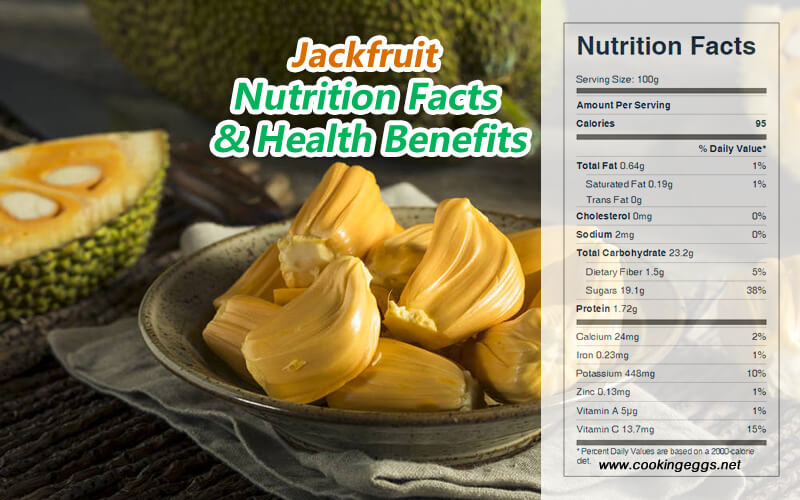Jackfruit Nutrition Facts & Health Benefits
Jackfruit is the largest edible fruit in the world and is a species of tree in the fig, mulberry, and breadfruit families. Its origin is Southeast Asia and it is a nutritionally rich fruit.
Jackfruit is a multiple fruit, consisting of edible (pulp and seed) and nonedible (rind and rachis) portions. The bean-shaped achenes of the jackfruit are coated with a firm yellowish aril (seed coat, flesh), which has an intense sweet taste at the maturity of the fruit. The pulp is enveloped by many narrow strands of fiber (undeveloped perianth), which run between the hard shell and the core of the fruit and are firmly attached to it. Jackfruit has a strong, pleasant aroma when fully ripe, and the pulp of the opened fruit tastes like a combination of apple, pineapple, mango, and banana.
Nutritional Value of Jackfruit
Jackfruit contains high levels of carbohydrates. The juicy pulp of the ripe fruit is eaten fresh as a dessert. The bulbs (excluding the seeds) are rich in sugar, fairly high in carotene, and also contain vitamin A, vitamin C, vitamin B6, thiamin, niacin, and riboflavin. Jackfruit is also rich in nutrients such as sodium, potassium, iron, calcium, zinc, and other nutrients.
The edible pulp is 73% water, 23% carbohydrates, 2% protein, and less than 1% fat. The carbohydrate component is primarily sugar and is a source of dietary fiber.
In a 100-gram reference amount, raw jackfruit contains 95 calories, 23.2 g carbohydrate, 1.72 g protein, 0.64 g fat, 1.5 g dietary fiber, 110 IU vitamin A, 13.7 mg vitamin C, 448 mg potassium, 2 mg sodium, 21 mg phosphorus, 24 mg calcium, 0.23 mg iron, 29 mg magnesium, and 0.13 mg zinc.

Jackfruit Nutrition Facts Label
Health Benefits of Jackfruit
Jackfruit is a rich source of potassium, with 448 mg found in 100 g of jackfruit. Studies show that foods rich in potassium help lower blood pressure and reduce the risk of stroke and cardiovascular disease.
Jackfruit also contains niacin, known as vitamin B3 and necessary for energy metabolism, nerve function, and the synthesis of certain hormones. A portion of 100 g of jackfruit pulp provides 4 mg of niacin. Boiling the root of the jackfruit and extracting and consuming it with its high nutritional content has been found to control asthma.
Jackfruit is rich in vitamin B6 (pyridoxine), which is one of the B vitamins, an essential nutrient. Vitamin B6 serves as a co-factor in cellular reactions, mostly related to amino acid biosynthesis and catabolism, but also involved in fatty acid biosynthesis and other physiological functions.
Another benefit of eating jackfruit is that it is a good source of vitamin C. The human body does not make vitamin C, so one must eat food that contains vitamin C to reap its health benefits. Vitamin C is an antioxidant that protects the body against free radicals, strengthens the immune system, and keeps the gums healthy.
It can slow down aging and cell degeneration. Jackfruit contains phytonutrients, including lignans, isoflavones, and saponins, that have wide-ranging health benefits. These phytonutrients have anticancer, antihypertensive, antiulcer, and antiaging properties. The phytonutrients found in jackfruit, therefore, can prevent the formation of cancer cells in the body, can lower blood pressure, can fight against stomach ulcers, and can slow down the degeneration of cells that make the skin look young and vital.
In addition to starch, jackfruit seeds contain a substantial amount of minerals, protein, fiber, and sugars, whereas pulps contain reasonable amounts of carotene and sugar. Seeds can be used to prepare bread or dry food in supplementation with other flours,such as wheat.